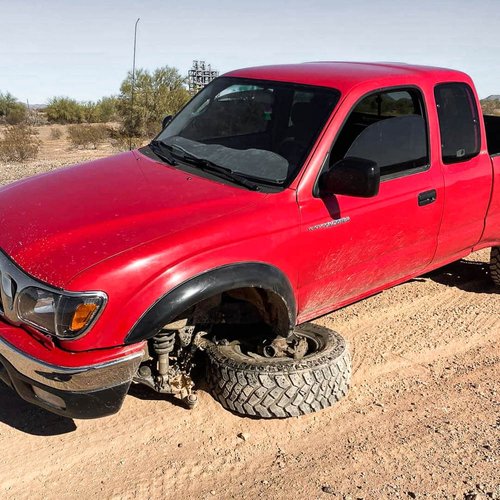Know It All Beforehand: Tacoma's Top 8 Problems and Fixes

Introduction:
The Toyota Tacoma is a reliable and famous truck. Toyota Tacoma’s have been popular trucks since 1995. All Tacoma models are better than their last ones. Tacoma’s are the most customizable trucks thanks to their aftermarket upgrades, which are easily available. However, like any other vehicle, the Tacoma may encounter issues that require attention. Let's dig in and explore Tacoma's top 8 most common problems, their causes, and how to fix them.

The Top 8 Problems with Tacoma:
- Throttle Position Sensor
- Sticky Accelerator
- Faulty Airflow Meter
- Automatic Transmission
- Bad Starter
- Parking Light
- Rust Corrosion
- Ball Joint Issue
Throttle Position Sensor:
The throttle position sensor lets your Toyota Tacoma's engine know the gas pedal's position. The engine controls then determine the throttle's position, the airflow to the engine, and the quantity of fuel transferred for the ratio of air and fuel.
Causes How to Avoid & Solve It:
Throttle position sensor failure may occur because of wear and tear from usage or carbon buildup on the sensor. This malfunction can be avoided with the timely servicing of your Tacoma. To fix this Tacoma problem, reprogram the sensor for an easy fix, and to completely resolve the issue, you should replace your throttle position sensor.
Sticky Accelerator:
The sticky accelerator may let you down; mechanical failure may be the cause of this issue. After higher milage is used on your Tacoma, its accelerator may get stuck at any time and can be very problematic. One of the reasons for a sticky accelerator or gas pedal is carbon buildup in the throttle, which can mess up the function of the butterfly valve in your Toyota Tacoma truck. A sticky accelerator could be a safety concern.
When you experience a stuck gas pedal, don't panic. Try the following steps for your safety.
How to Manage If Your Vehicle Gas Pedal is Stuck:
- Turn your hazards on.
- Try to pull your Tacoma to a safe place
- Park it on the side of the road
- Shift your truck to neutral
- Apply the brakes
- Call for help (call a mechanic)
Causes How to Avoid & Solve It:
Causes of a sticky accelerator are dirt or debris; wear and tear can cause the gas pedal to get stuck. However, the main cause that can affect and damage it is carbon buildup on your Toyota’s electronic throttle control system, which may affect the accelerator pedal position sensor.
These problems can be avoided with the timely servicing of your Tacoma, proper cleaning of the paddles, and the installation of the right size of floor mats in your truck, especially under the driver's seat, to avoid overlapping the pedals.
Faulty Airflow Meter:
If you don't pay attention to your defective throttle position sensor, that causes your Toyota Tacoma to have a sticky accelerator problem, which will affect the calculations of the amount of air thrown to the engine needed for engine combustion.
A faulty airflow sensor may lead to delays in acceleration and reduced fuel efficiency, and the engine will burn more fuel, resulting in black smoke from the exhaust pipe.
Causes How to Avoid & Solve It:
This fault in your Tacoma is typically overlooked until the check engine light is on and the onboard diagnostic scan tool discovers a Mass Air Flow sensor fault code. For good airflow and to avoid this error you can upgrade to a good Tacoma front grill, which will increase the airflow to your engine.
This sensor in your truck can malfunction due to dirt collection. However, if the problem is still there after cleaning the sensor, you may need to replace the sensor unit.
Automatic Transmission Problem:
When the car gets older and becomes worn, Tacoma can't be excluded from that category; all machines will be worn out after a longer period. Automatic transmission may occur, which causes the transmission to shift in the wrong gear. This problem can cause dangerous safety hazards as the gear shift may lead to delays in movement and accidents.
Causes How to Avoid & Solve It:
This automatic transmission arises due to an issue in the throttle position sensor or a fault in the shift solenoid. The automatic transmission fault affects trucks that exceed anywhere from 125000-150000 miles.
To avoid this problem, the Toyota Tacoma owner should keep an eye on the throttle position sensor; it must be readjusted or reset. If this does not work, the shift solenoids may need to be replaced. It's not necessary to change all shift solenoids at once; your Tacoma mechanic will find which shift solenoids should be replaced.
Bad Starter:
The Toyota Tacoma engine is extremely trustworthy, yet a highly durable engine can malfunction at times. A bad starter won't turn the engine of your truck.
Causes How to Avoid & Solve It:
Again, this issue is caused by the fact that the Tacoma truck is more at risk for a broken starter at higher mileages of 100,000 to 125,000 kilometers.
To fix the problem, owners should replace the wires on the starter solenoid.

Parking Light:
Tacoma’s most common problem is that after a longer period and a lack of attention to small repairs and services, the lens of a parking light melts because it can’t withstand the heat of the bulb.
Causes How to Avoid & Solve It:
After 23000 to 80000 miles of your Tacoma truck, the owners can find melted or cracked lenses on the front parking light because of the heat they produce.
The solution to this issue is to replace your Toyota Tacoma front headlights and back lights with LED lights. There are many aftermarket Toyota Tacoma LED front lights and back lights. To avoid the problem fixed in emergency Tacoma's, owners can replace headlights and taillights gradually.
Rust/Corrosion:
This was one of the most serious issues with the first-generation Toyota Tacoma. Rust will ultimately accumulate in any car with a steel frame or even aluminum, but it appeared promptly in the Tacoma.
Causes How to Avoid & Solve It:
Regular cleanings are the first step in preventing rust damage on your Tacoma. Ideally, you should wash and wax your vehicle every few weeks and at least twice a year. This will keep sand, dirt, and other foreign objects from rubbing through the paint.
To remove rust, scrape off the surface rust (ideally, this is all there is), then paint over the rust, let it cure, and then apply wool wax. Some studies show the fluid film can resolve the rust. It stinks and is harsh on rubber, causing it to swell.

Ball Joint Fault:
The Toyota Tacoma ball joint wears out more quickly than the others. The ball joint controls the navigation; it connects the steering to the wheels of your Tacoma. Because the ball joint malfunctions, the car can drift from right to left, which is dangerous. Tacoma owners may avoid driving at all costs.
Causes How to Avoid & Solve It:
Ball joint problems in Tacoma may occur because of rust on the frame.
- Clean your truck's underbody, taking specific care of the wheels. Rust on your wheels has the potential to spread to the ball joints and frame.
- Always keep an eye out for warning signs from your ball joint. It rarely fails abruptly, as the problem frequently causes clunking sounds or vibrational noises. These are indicators that you should have checked.
- Inspect your ball joints regularly as well, as these are critical components of your Tacoma. If your ball joints fail, your truck will fail as well.
To resolve the problem, you need to replace the ball joint, and after replacing it, you need to align all the tires of your Tacoma.
Conclusion:
In conclusion, the top 8 Toyota Tacoma problems usually occur after a longer period of use, yet every issue can be fixed through the timely replacement or repair of the parts. Most Toyota Tacoma owners are truck enthusiasts and take good care of their Toyotas to maintain them. They customize and update their trucks with compatible parts and highlights.
Make sure to note any issues before the alarming situation. The more issues there are, the greater the risk of your truck getting damaged, and the more attention may be paid to the situation. Also, before making any repairs, see if your Tacoma has a warning for the same problem. They are typically the result of manufacturing faults. As a result, Toyota has a better chance of preventing the same issue from recurring.
